At first it was a model that was not going to be sold in the old continent, but seeing the rise of the A-segment, Ford changed its mind. And it did the right thing
The first detail we notice is that it's no longer called Ka "a secas", now it's Ka+. And why Ka+? It's obvious, isn't it? The previous generations barely exceeded 3.6 meters and only existed with three-door bodywork. This "+" comes from offering a bigger and wider Ka than the original without losing its essence: that of being one of the best city cars. It is only available as a five-door.
It measures 3.93 metres long, which leaves it halfway between an A and a B segment. In fact, it's just 4 centimetres short of the Ford Fiesta V (they're based on the same platform). It has five doors, which greatly facilitates the practicality of the car, and has five seats, one more than before. But although it has one more than before, to be honest, in practice it will be quite uncomfortable for those who sit behind to accommodate a fifth member inside the car. It measures 1.69 metres wide in total.
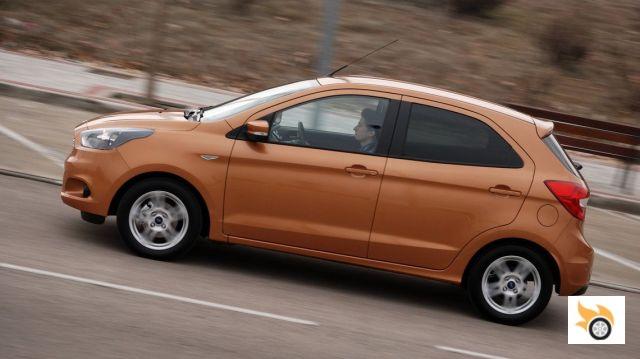
That said, four passengers are better than five passengers is nothing new, and it doesn't detract from the car by any means. With a wheelbase of 2.49 meters and a height of 1.52 meters the interior space is incredible for the smallest segment of the market. The 270 litres of boot space are not bad either. I think you start to notice that one of the best assets that this car brings up its sleeve is the space on board...
If you're looking to buy a Ford Ka+, luckily (or unluckily) you don't have to think too hard. There are only two trims available: Essential and Ultimate; there are also Black & White Edition and White & Black Edition trims, but they're based on the Ultimate. The only engine available is a naturally aspirated 1.2-litre petrol four-cylinder offered with both 70bhp (Essential) and 85bhp (Ultimate).
Either trim level is always paired with a five-speed manual gearbox - there's no automatic or automatic as an option. Otherwise, you can choose from a single design of alloy wheels or hubcaps, six body colours, a couple of packages which I'll talk about later and some rather interesting optional extras. No, it's not a car that you can customize a lot, although there are more possibilities than in an Opel Karl, for example.
For 8,100 euros you can get a Ka+, but it's worth it to dig a little deeper into your pocket and shell out 9,300 euros for the Ultimate trim. The most you can spend on it is 11,325 euros.
A bit of a long introduction, I know, but it's worth knowing all the main details before going a bit deeper.
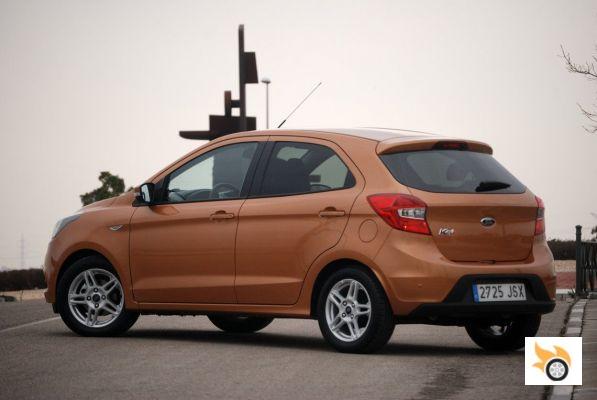
Design
The design of the Ford Ka+ doesn't flaunt styling or evoke dynamism, it doesn't pretend to. It's a simple, functional car whichever way you look at it. For example, the roof has hardly any drop at the rear, which provides good headroom for passengers and a higher boot height. And that's not a bad thing either, not everyone likes to be the centre of attention, some people are just looking for a car to get around in and prefer function over form. Originally, the car was intended for emerging markets, but Ford has decided to repeat the move it made with the EcoSport: design it initially for these markets, and then refine it as an access vehicle to the first car in developed markets.
We are facing a B-segment of 20 years ago, but with fully updated equipment elements and very "Europeanized". Under the "One Ford" philosophy, Ford's North Americans are working to offer, with certain variations, the same car in all markets. Under the design language of the brand, called Kinetic, the Ka + is seen at first glance to be a Ford, although easily differentiated from other models of the brand of the oval. The large trapezoidal grille with the brand's emblem above it and the headlights stretched towards the A-pillar denote its origin.
Despite being an economy car, it doesn't look that way on the outside. The bumpers, door handles and mirrors are painted in the body colour, the grille is chrome and the bonnet and door ribs give it more presence. Okay, it doesn't have full LED headlights with a three-dimensional design, panels with totally unnecessary reliefs or an exhaust outlet with a spectacular design that are increasingly fake (Mercedes-Benz, ahem), but that would only serve to increase the price of the car and that's not what you're looking for.
Another point where function over form comes to the fore is in the windows. Thanks to the high height of the car, the distance from the waistline to the roof is large, which results in a fairly large glazed area, especially for passengers sitting behind, who will not feel overwhelmed. And that's to be welcomed, because nowadays, being in the last row of seats in a car means you can't see a damn thing through the windows. Drastic example with knowledge of cause: Toyota C-HR.
A detail not very visible but that I think is relevant is that it doesn't have any button to open the trunk door, on the outside I mean. It can only be opened by a button on the car keys, or by a button on the inside located next to the wheel of the lights. Another detail, already for sybarites, is that some body panels do not seem homogeneous to fit, watch out for the A-pillar.
There are two finishes that add a bit of distinction to the Ka+: Black & White Edition and White & Black Edition. Both correspond to the Ultimate trim
If we're looking to add a personal touch to our Ka+, there's little we can do. The optional 15" rims with star design are the only options (250 euros). We can also tint the windows (120 euros) or have it painted in any color other than Bright Yellow, the only one that does not involve an extra cost. If we want it white, we will have to pay 200 euros, but if we want it in blue, black or grey, we will have to pay 425 euros. Ruby Red and Amber Gold (like the one in the photos) cost 650 euros.
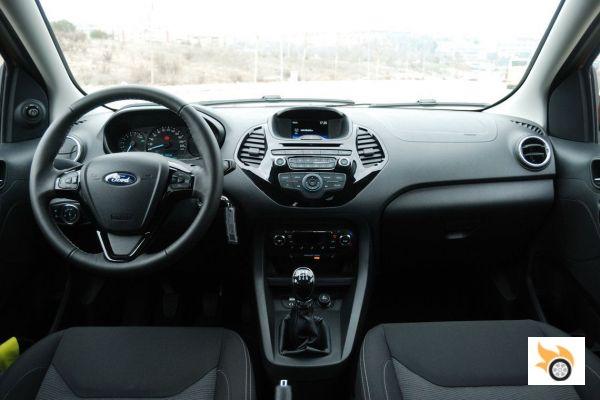
Cabin
It's time to get inside the urbanite. First dilemma: perceived quality vs real quality. We won't find soft plastics anywhere, they are all hard plastics. Apparently they are of good quality and seem to fit well, although time will tell if they are really good or not.
The design of the dashboard reminds us of the previous generation Fiesta, with a slanted design and lots of buttons. Is it hard to do with so many buttons now that we're so (badly) used to screens? Not really, although the fact that it's equipped with a first-generation SYNC multimedia system means that the small 4.2" screen isn't touch-sensitive and you have to use buttons, which are less intuitive than touchscreens. That it's more than amortized helps contain the price. If you don't have SYNC, there's a compartment at the top that's ideal for leaving your mobile phone in, the lid can keep it secure and visible.
And speaking of the SYNC system, it includes AM/FM radio, AUX, USB, emergency assistant, voice control, voice call and My Key function. The latter serves to select a volume limit on the car's audio system, a reminder to buckle up, or even limit the car's top speed. It sounds silly, but it's pretty handy if you have to lend the car to someone and don't want them to go messing around. So if you're a parent and you don't trust your kids much, you know what to do. The screen also controls many of the car's commands. After all, infotainment systems are a one-stop shop for just about everything.
To opt for SYNC you have to go for the Ultimate trim. Incidentally, you can't even get a navigation system as an option.
Under the infotainment system we find a single-zone climate control (optional, 300 euros), a small hole with rubbery base that will prevent the phone from slipping on our journeys (MyFord Dock), and AUX, USB and 12V ports. Behind is the gear lever, which is quite high off the floor and seems small, with a relatively short travel. A good detail this last one, because it means that it is quite simple and comfortable to use, and yes, you will have to use it often.
The rest of the dashboard is not worth mentioning. The dashboard is also simple, very nineties if I may say so. The on-board computer is blue monochrome and displays instantaneous fuel consumption, average fuel consumption, remaining range, average speed, total and partial kilometres. Whenever you start the car, the Ford logo appears in "8 bits" and it doesn't matter on which screen you left the on-board computer last time, the total mileage will always appear.
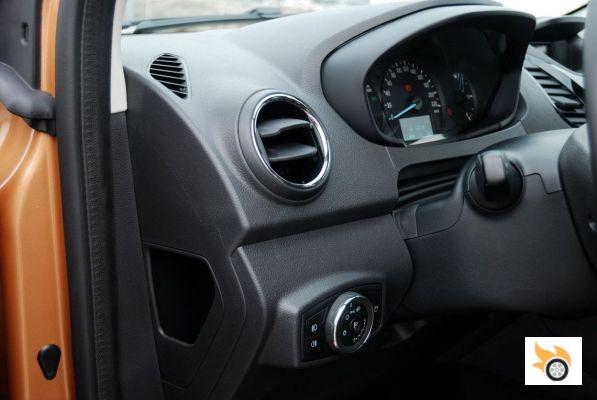
I found the steering wheel particularly pleasing, with a thickness and rim size that is just about perfect. It will be the only place in the car where we find leather besides the gear lever cover. Through it, apart from managing the direction of the car and play the horn, we can handle the cruise control, (optional, 225 euros) as well as the audio system and voice control. It can be adjusted in depth and height, something that not all cars of this price can be done. Another detail in its favour is the height adjustment of the front seat belts.
The seats can also be adjusted in height and depth, so finding a comfortable driving position is easy. The tested unit had heated seats as an option (250 euros), which work very quickly and can even be unpleasant. A good while with the heating on and you'll end up with a scorched arse, even if it's on the lowest setting (there are two intensities: strong and very fucking strong). The good thing about this option is that it also includes a folding armrest for the driver's seat, which is quite comfortable on long motorway journeys.
Other details such as the metallic door handles help to make the whole package not too low cost. And speaking of door handles, it is surprising that there are no handgrips in any of the seats, not even on the roof there is no mould for them. The City Package (480 euros) also helps with other interesting details: folding and electrically adjustable mirrors, electric rear windows and rear parking sensor.
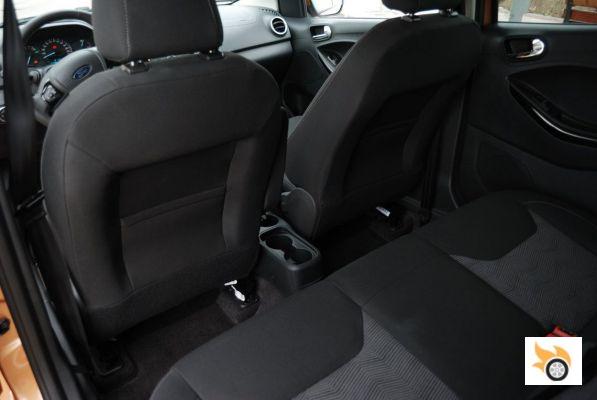
So far so conventional, but there's one thing that stands out in the Ka+ above any other car. A Sugus for the guesser: 3, 2, 1... Right! The interior space (applause), especially when it comes to storage and longitudinal legroom for the rear passengers.
It has no more and no less than 21 storage spaces. Of course, all of them are at the front, because at the back, because there are none, it doesn't even have enough space to store a needle. The holes behind the handbrake are very well resolved, with a bottom lined in rubber -an unusual detail of the segment- that will prevent what we put there to move a lot or make noise when we go on the move by rubbing. But the most surprising cavity is perhaps one that is hidden on the far left side of the dashboard, only accessible by opening the driver's door, as this hides it. A space that comes to the finger to store valuables that do not want to be left in sight.
The feeling of spaciousness is striking, both for the front and rear seats. According to Ford, the Ka+ is a segment leader when it comes to headroom in the front and legroom in the rear.
Ford claims that a two-metre occupant can sit in the back with the front seat adapted for a two-metre driver.
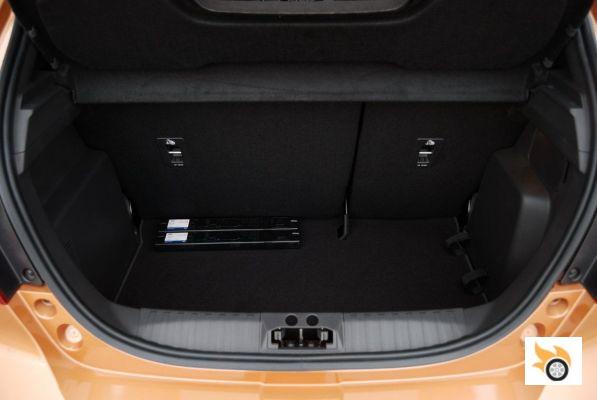
The boot capacity doesn't stand out compared to the latest generation of cars, but the 270 litres of capacity is consistent with its size, with good headroom up to the top tray, and that includes an emergency spare wheel (100 euros). The rear seats can be folded asymmetrically (60/40) as standard. I can attest that carrying a full-size spare wheel is a great help, better than the widespread anti-puncture kits. A note in case you get a flat tire: it doesn't have any specific support for the jack, you have to put it by eye. It should also be said that the tire pressure sensor does its job well. Yes, you guessed it, I had a puncture.
The equipment is quite complete considering the low price of the car. As standard there are six airbags, including rear and curtain, ABS, ESP, hill start assist, speed limiter, fog lights, third rear head restraint (surprisingly nowadays it doesn't come as standard in many cars), 14" steel wheels... and all that in the Essential trim.
Apart from the options that I have mentioned throughout the article, in this last finish you can only choose the Cool Package (750 euros), which includes manual air conditioning and CD radio with Bluethooth. In addition to the aforementioned alloy wheels (250 euros), we can add tinted windows (120 euros), climate control (300 euros), heated seats (250 euros), City Package (480 euros), cruise control (225 euros), standard spare wheel (100 euros), a perimeter alarm (100 euros).
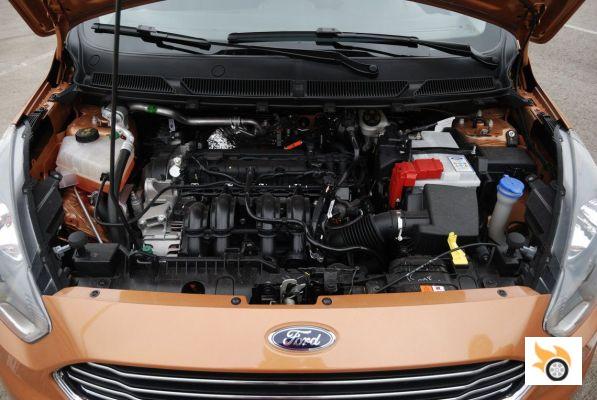
Technical
A single petrol engine and two power ratings make up the mechanical range of the Ford Ka+. We are seeing that, progressively, the engine range of A-segment cars is focusing on petrol engines. Most sales will probably be of the 85 hp model, not only because it has that extra power, but also because it is much better equipped than the Essential trim and the price difference is not high.
The engine block is already known and used by Ford for many years: a 1.2 Duratec Ti-VCT. It is a four-cylinder with atmospheric intake available with both 70 hp and 85 hp, the latter being the one we tested. All the power is delivered to the front wheels with the peak at 6,300 RPM and peak torque of 112 Nm at 4,000 RPM. In fact, it's not until that rpm range that the engine starts to respond with dignity. When you open the (somewhat heavy) bonnet you'll see it proudly displayed, it's not covered or arranged with finishes that make it look prettier.
The performance is quite discreet, with a 0 to 100 km / h in 13.3 seconds and a top speed of 169 km / h, according to our system is a suspense. For the 70 hp version they are even more discreet: 15.3 seconds 0-100 km/h and 159 km/h top speed. On paper it's not too bad for the type of car we're talking about, but in daily practice, even though we haven't tested the 70 hp version, the more powerful version isn't exactly overpowered. It doesn't weigh much, 1,084 kg, although I'm sure it could be reduced by a few kilos.
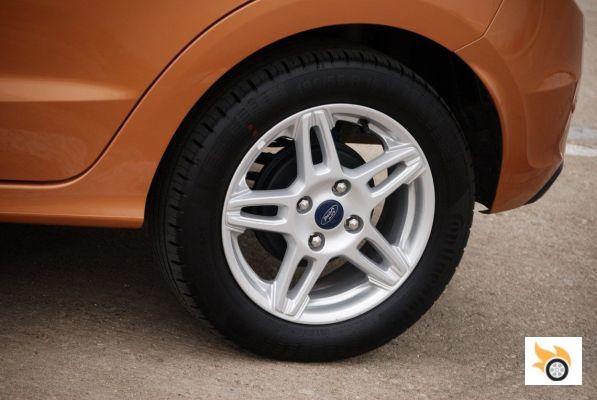
However, what most penalizes this car is the aerodynamics. Precisely one of its best assets is one of its biggest penalties. Why? Thanks to its height it is very wide, but it offers a lot of air resistance, which means forcing the engine to run more and, consequently, higher consumption. It is already known that a short, tall, boxy car is not exactly the best formula for good aerodynamic penetration... aerodynamics.
With a Cx of 0.35 the Ka+ is one of the least aerodynamic cars in the segment.
Before talking about fuel consumption, we should mention another aspect that influences it: the gearbox. We've already seen that the engine isn't the latest engineering feat and that, in order for it to respond well, it has to be revved high. It's not the lightest car, but it's not a whale for its size. The aerodynamics aren't the best in the world either, but if the gearbox isn't well designed, we're going downhill and without brakes. Fortunately it's good. This is a car whose aim is low cost in all aspects, that includes low fuel consumption as well.
The first two gears are very, very short. Starting in second gear from a standstill doesn't make much of a difference in effort compared to first. Third and fourth are not very long either, although in third it would reach 136 km / h at the injection cut of 6,500 RPM, a long development. But the fifth gear is clearly a relief, it has a very long development. If we ask the car to respond in this gear, or in fourth, we have it clear. The gear we will use the most is probably third, it is the most "neutral". Therefore, if we want to make good consumption without having to go at a snail's pace all the time, we will have to play a lot with the gear lever to find the balance between response and optimal speed. It's not a major drawback. In fact, if you like driving at all, you'll even have fun doing so many gear changes. It's very smooth and precise, it's a pleasure to use, and it needs to be.
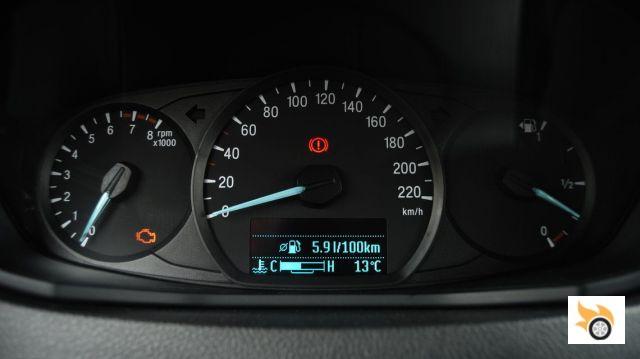
In both power levels, the homologated consumption is the same: 5 litres per 100 kilometres. In recent years it has been said that you have to add in the order of one to two litres to the homologated consumption to know the real consumption, and this case is no exception. The average fuel consumption during the test was 5.9 litres for 450 km, and many of them were in the city. It has a 42-litre tank, so it shouldn't be necessary to stop to refuel until after 600 km following that average.
As far as the chassis is concerned, it basically goes like a Fiesta (same base), but with a slightly softer suspension springs and damping. On the front axle we find a McPherson type suspension with coil spring, while at the rear is a torsional axle. The steering is also the same, with 2.6 turns of the steering wheel between stops and 10.7 meters of turning diameter, a rather high figure for the type of car it is.
The brakes, without being gigantic, consist of 258 mm ventilated discs at the front and 200 mm drums at the rear; more than enough for everyday use, but not unnecessarily generous. The 195/55 R15 low rolling resistance tyres do their job of finding a compromise between efficiency, grip and comfort, and they're from a good brand, Continental.
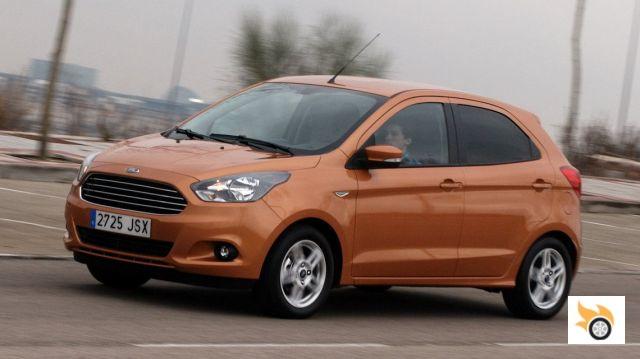
Driving
During the days I had the Ka+ in my care, it proved to me that it's a very capable car in the hotly contested city car segment. It's all-round, extremely practical, but you have to be aware of its limitations, especially when it comes to the engine.
Almost all cars nowadays have pedals and steering that err on the side of being too soft. In this case, they are, but without the qualifier "too much". The steering is electrically assisted and, even so, you can feel something (but not much) between the wheels and the asphalt. I also liked the feel of the pedals, but not so much the layout of them. Yes, they're all arranged in the same order, but the difference in height between the three pedals is very noticeable, with the clutch very close to your leg and the throttle very far away from it.
Visibility is good, thanks to the large glass area as I mentioned earlier. If we join that with the rear parking sensor, we have a car that won't make parking maneuvers difficult. The only thing missing to be perfect in that purpose would be a smaller turning radius.
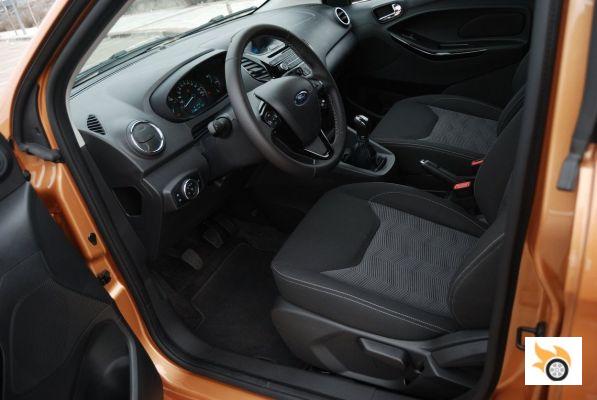
In the city is a car that handles like a fish in water, we will not miss more power unless we want to go skidding wheel of the traffic lights (note: traction control is disabled from one of the submenus of the SYNC system). The 1.2 is an engine that delivers power in a very progressive way and many times we will have to sink our foot into the carpet if we want to gain speed safely. Instead of 85 horsepower it feels like it has 85 ponies, to be honest.
Fortunately the first gears of the gearbox are short and help to a decent acceleration. If we go flat, we can even go in fourth through the crossings of our town without going over the legal speed limit. The good thing about this engine is that it is very smooth, it doesn't jerk or rattle, and the fuel consumption doesn't shoot up if you put your foot down, unlike a turbocharged engine. In other words, it's more desirable than most three-cylinders in its class.
We'll especially notice the lack of power at low revs, as it's an engine that works well in the high rev range.
We recently tested the Opel Karl, and with one less cylinder, less power and less torque, it seemed to be a more "reactive" car. And now that I compare it with the small German, isn't it curious that doing a similar driving, going through the same routes and with a similar mileage, the consumption is exactly the same? You're supposed to be driving a modern one-litre, 75bhp, 95Nm three-cylinder whose consumption should be lower than that of a more ancient 1.2 four-cylinder. Well, it seems that downsizing is not so noticeable in practice, what a surprise!
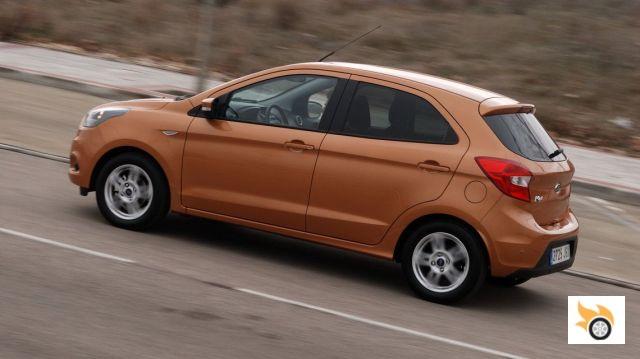
If it had Stop&Start maybe it would be possible to save a few tenths of a second on fuel consumption, but it would be adding more complexity to the technical part of the car and it might raise the price a bit. However, in my humble opinion, I think that all A and B segment cars should have this system. Most of the miles they drive are on urban roads, they are designed for them. Anything that can improve fuel economy is always welcome, and even more so in cars that aim to make them sip gas.
On the open road, the Ka+ defends itself just enough. Due to the high air resistance it offers, aerodynamic noise becomes quite noticeable as soon as we exceed 100 km/h. Where you'll hear it most is in the rear-view mirrors, whose shapes don't help. The engine is barely audible from the passenger compartment as long as you don't exceed 3,500 revs. Although taking it above that speed will be relatively common since, below 2,000 RPM, the response is null when stepping on the right foot, something normal on the other hand.
When it comes to cornering it is a very neutral and predictable car. It has very basic suspensions, like the rest of its rivals, but they do their job. It is true that it balances a lot and does not recompose quickly, but the suspension settings give priority to comfort over anything else. Despite carrying the same scheme as the Fiesta, the latter feels more dynamic with a suspension and springs somewhat harder. And of course, if we add to this formula a fairly comfortable seats we find a car whose journeys in it will be pleasant.
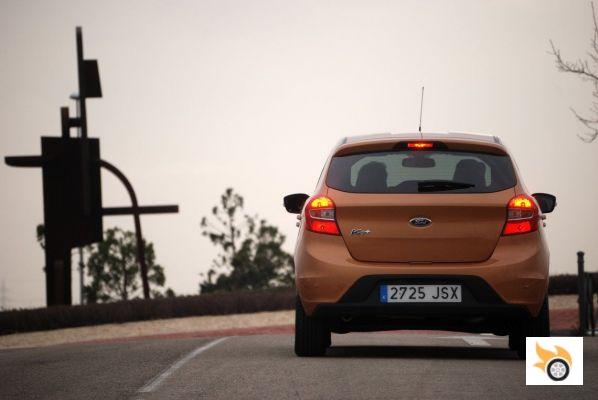
Conclusions
Ford has made a good move with the Ka+. In Europe there are still many people who want a small car with which to move around the city with maximum satisfaction per euro invested. For less than 10,000 euros, the car you can take home is quite well equipped and defends itself more than well in day to day life. It is an option to take into account if we want it as a second car or as a car to start driving.
Its power is limited, but playing with the precise and why not? fun gearbox we will learn to drive efficiently and make the most of the resources it offers. It's simple, you don't need to study a manual to learn how to use it. The only "complicated" thing is to get used to the SYNC system, but if you go through the menus you'll get used to it in no time.
Its maintenance is cheap and, by using proven components, we are also facing a car that, surely, is reliable.
Besides that, we have a big plus point: space. For a car of less than four meters, the interior space is greater than that of rivals of higher segment. It's a car that makes good use of its space.
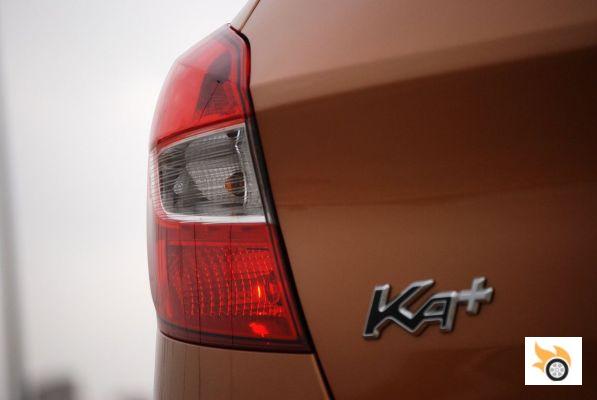
Let's look at where the Ka+ came from. It was designed for emerging markets. What does that mean? That the car has to be cheap, practical and reliable, and it delivers. As it is "Europeanised", it has been further refined and adapted to the best of its ability to meet the standards of the old continent. That is, the door locks have been improved, the engine is mounted on hydraulic mounts instead of rubber, the rear silent-blocks have been reinforced (for more stability), the suspension is 10 mm lower, the front anti-roll bar is 47% stiffer and the soundproofing has been generally improved. It doesn't look like it, but the guys at Ford have adapted it very well to our market. Apparently, the formula works.

























